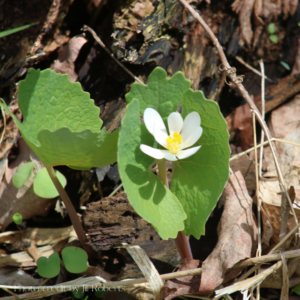By Jill Roberts
One of the earliest signs of spring in the northeast is the Sanguinaria canadensis, or more commonly referred to as bloodroot or black salve. This charming plant is tremendously valuable to our planet as a natural dye and remedy, but it’s becoming increasingly more extinct in the United States.
Its delicate white flower, green foliage, and dark red roots can also be irritating to the skin, and deadly if consumed in large quantities. So please keep little fingers and dog snouts at a safe distance, and educate yourself before propagating.
The dark red sap, found mostly in the plant’s thick roots, is what packs the punch. It was used by native medicine men and introduced to the colonists by Native Americans as a dye to color skin, clothing and baskets. As such, the plant may also be referred to as “puccoon,” which is a Native American term meaning, red dye.
The sap has since been used topically as a treatment for various skin afflictions, including warts and eczema. It’s also known to induce sleep and has many antibiotic and anti-inflammatory properties. Studies are currently underway in the United States for its use as a skin cancer treatment.
Each solitary plant produces a single white flower with a gold stamen, and only blossoms for a few days in early spring. When the sun goes down, the plant’s green foliage folds over the flower to protect its delicate petals. Once the flower fades, the leaves will continue to grow and reach a size of 6 to 10 inches, before they turn a deeper green through mid-summer, and die back in late summer into early fall.
I happened upon this small patch of bloodroot plants along a trail near Bantam Connecticut back in 2019. Not surprisingly, it’s an area known for its Native American heritage. Although it’s more common for the plant to bloom in late March through early April, this photo was taken on April 29th of that year. Perhaps we had a cold spring in 2019, or perhaps the wild perennial blooms a little later in the northwest hills. Either way, I consider myself lucky to have spotted it.

References:
An Annotated Bibliography By Mary. L. Predny and James L. Chamberlain (https://www.srs.fs.usda.gov/pubs/gtr/gtr_srs086.pdf)
Bloodroot Plant Care: Learn How To Grow Bloodroot (Sanguinaria Canadensis) By Becca Badgett (https://www.gardeningknowhow.com/ornamental/flowers/bloodroot/how-to-grow-bloodroot.htm)

